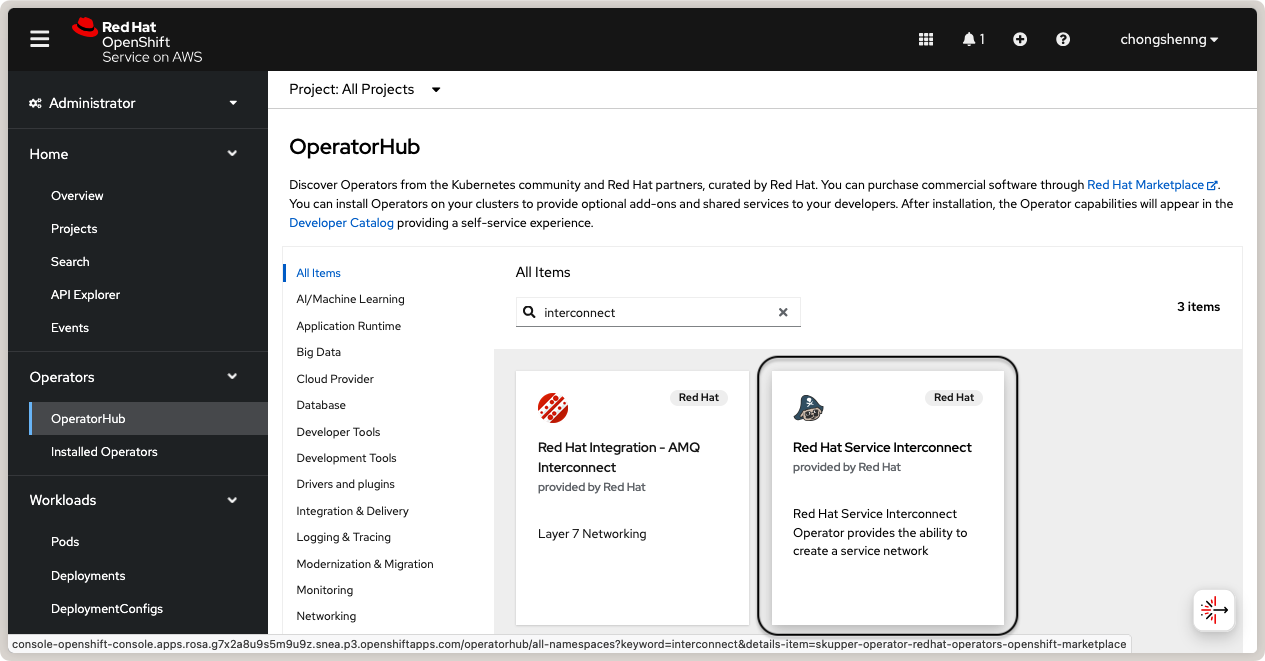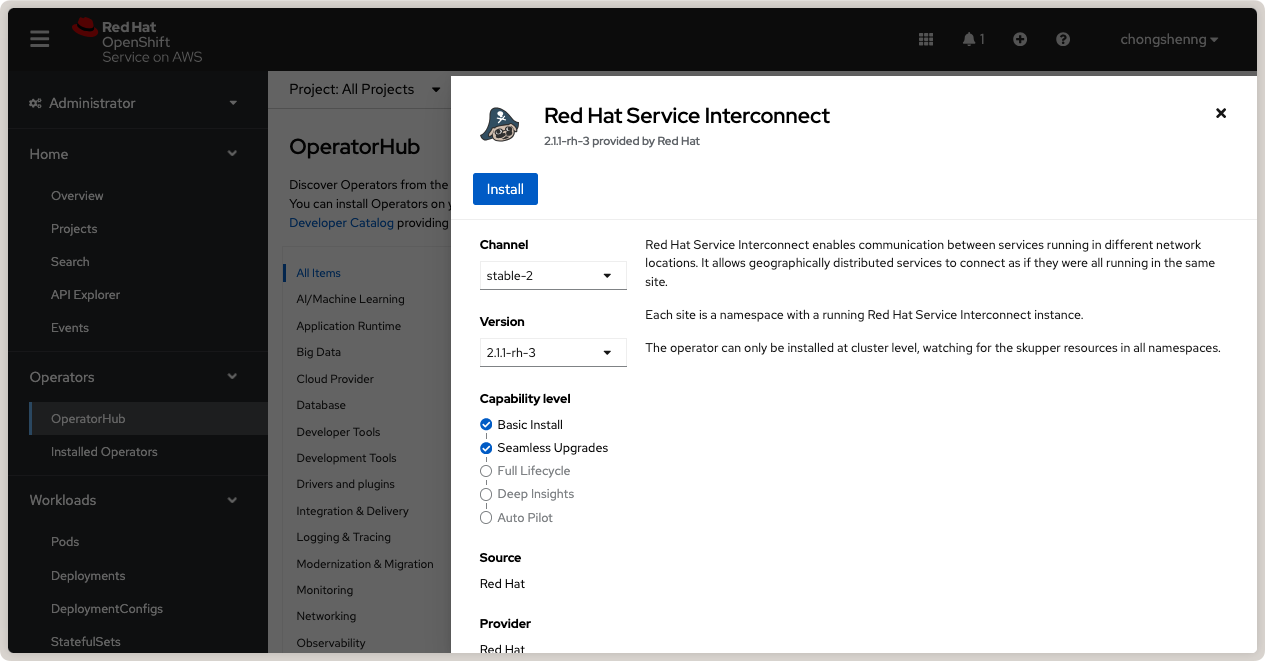Run Flower on Multiple OpenShift Clusters¶
In this guide, you will learn how to deploy Flower in multiple Red Hat OpenShift (RHOS) application platforms. This deployment pattern is useful when connecting multiple OpenShift clusters deployed in environments that run critical workloads, such as in secure research environments (also known as trusted research environments, or secure data environments), datacenters, high-performance computing clusters, or on-premises servers.
Note
This guide assumes you have a working knowledge of OpenShift and have deployed Flower in a single OpenShift cluster before. If you are new to OpenShift or Flower, please refer to our guide on how to run Flower on OpenShift before proceeding with this multi-cluster deployment.
To connect multiple OpenShift clusters, we will use Red Hat Service Interconnect. Based on the open source Skupper project, the Service Interconnect simplifies connections between sites. Applications and services, such as SuperLink and SuperNodes, can communicate with each other using the interconnect as if they were in the same network.
Skupper works by creating a site in each cluster, with a router (or routers) that connect to other sites over the application network. The application network is the network that connects multiple K8s clusters. So, the cluster where SuperLink is deployed requires a Skupper site to accept links and route incoming traffic and the cluster where SuperNode is deployed must have a Skupper site to join the application network and route outgoing requests via the interconnect.
Pre-requisites¶
Install the Skupper CLI on your local system by following the instructions on the Skupper website.
Install Kubectl tools on your local system by following the instructions on the Kubernetes website.
Create OpenShift Clusters¶
For this guide, we will create two OpenShift clusters using the Red Hat OpenShift
Service on AWS (ROSA). Follow the steps in our companion guide here
on deploying the clusters. In this guide, we will assume that your clusters are deployed
in different AWS regions or availability zones.
Next, deploy SuperLink in the first cluster. For reference, you can follow the deployment steps in our companion guide.
Install Service Interconnect Operator¶
In each OpenShift cluster, install the Red Hat Service Interconnect Operator from the OperatorHub:

Search for Red Hat Service Interconnect Operator on OperatorHub.¶

Install Red Hat Service Interconnect Operator from OperatorHub.¶
Create Skupper Sites¶
From your local system, you will now create a Skupper site in each OpenShift cluster and connect the sites to form an application network.
First, set the namespace in your CLI by logging in to your first OpenShift cluster (the one with SuperLink deployed):
oc login --server=<your-openshift-api-endpoint> --web
If successful, you should see a message similar to this:
$ oc login --server=<your-openshift-api-endpoint> --web
Opening login URL in the default browser: [...]
Login successful.
You have access to 81 projects, the list has been suppressed. You can list all projects with 'oc projects'
Using project "default".
Now, switch the project to the project name (i.e. namespace) where you deployed SuperLink:
oc project <your-namespace>
In our previous guide, we used the project
name flower-openshift-demo, so let’s do that:
$ oc project flower-openshift-demo
Now using project "flower-openshift-demo" on server "<your-openshift-api-endpoint>".
Astuce
If you are unsure of the project name, you can list all projects you have access to
using the command oc projects. You can also check that you are in the correct
context by running oc whoami --show-context.
With the correct namespace set, create a Skupper site in this cluster:
skupper site create superlink-interconnect --enable-link-access
This command creates a Skupper site named superlink-interconnect and the
--enable-link-access option enables external access for links from remote sites;
this option is necessary for the site where SuperLink is deployed so that SuperNodes in
other clusters can connect to it. You should see output similar to this:
$ skupper site create superlink-interconnect --enable-link-access
Waiting for status...
Site "superlink-interconnect" is ready.
Finally, repeat the steps above to create a Skupper site in the second OpenShift cluster (where SuperNode will be deployed). Log in to the second cluster, switch to the correct namespace, and create the Skupper site:
oc login --server=<your-openshift-api-endpoint> --web
oc project <your-namespace>
skupper site create supernode-1-interconnect
Note that the namespace can be different from the first cluster and depends on the
project name you created in the second cluster. Note also that we do not use the
--enable-link-access option in the Skupper command because this site only needs to
connect to the SuperLink site.
Link Skupper Sites¶
Now that we have created Skupper sites in both clusters, we will link the sites to form an application network.
From your local system and in the namespace of the SuperLink cluster, generate a
Link resource as follows:
skupper link generate > superlink-interconnect-link.yaml \
--namespace flower-openshift-demo
Astuce
For more information about the concepts of sites and links, please refer to the Skupper Link concepts.
This command generates a Link resource and saves it to the file
superlink-interconnect-link.yaml. The --namespace option specifies the namespace
of the SuperLink cluster.
With the Link resource generated, switch to the namespace of the SuperNode cluster,
and apply the resource in it:
kubectl apply -f superlink-interconnect-link.yaml
You should see output similar to this:
$ kubectl apply -f superlink-interconnect-link.yaml
link.skupper.io/link-superlink-interconnect-skupper-router created
secret/link-superlink-interconnect created
To verify the status of the link, run the following command:
skupper link status
You might need to issue the command multiple times before the link is ready:
$ skupper link status
NAME STATUS COST MESSAGE
link-superlink-interconnect-skupper-router Pending 1 Not Operational
$ skupper link status
NAME STATUS COST MESSAGE
link-superlink-interconnect-skupper-router Ready 1 OK
Create a Connector¶
A connector binds a local connection endpoint to connectors in remote sites, which in this case is the SuperNode cluster. This allows SuperLink to communicate with SuperNode. Listeners and connectors are matched using routing keys. In the first cluster (where SuperLink is deployed), create a connector using the following command:
skupper connector create <name> <port> [--routing-key <name> --workload <workload-name>]
Here, <name> is a name for the connector, <port> is the port number that the
connector will listen on, and --workload <workload-name> is an optional argument
that specifies the name of a workload (i.e. deployment) to associate with the connector.
The <name> is the default routing key if the --routing-key option is not
specified.
In our deployment, SuperLink listens on port 9092 corresponding to the Fleet API
(for more details, read our reference on Flower network communication). Since we have given
the SuperLink deployment the name superlink, we will use that as the workload name:
$ skupper connector create fleet-api 9092 --workload deployment/superlink
Waiting for create to complete...
Connector "fleet-api" is configured.
Create a Listener¶
A listener binds a local connection endpoint to connectors in remote sites, which in this case is the SuperLink cluster. This allows SuperNode to communicate with SuperLink. On the second cluster (where SuperNode will be deployed), create a listener using the following command:
skupper listener create <name> <port> [options]
The <name> is the name of the listener resource, and will be the default routing key
and host if the --routing-key and --host options are not specified. In our case,
the <name> must match the name of the connector we created in the SuperLink cluster,
which is fleet-api. The <port> is the port number that the listener will listen
on, which must also match the port number of the connector (9092):
$ skupper listener create fleet-api 9092
Waiting for create to complete...
Listener "fleet-api" is configured.
Deploy SuperNode in a Separate OpenShift Cluster¶
With the listener created, we can now deploy SuperNode in the second OpenShift cluster
using the listener service created by Skupper. The listener service is a Kubernetes
service that Skupper automatically creates when you create a listener. You can find the
DNS of the listener service by navigating to the OpenShift console > Networking >
Services, and look for the service named fleet-api. The Hostname is listed under
the Service details section.
Copy and paste the following YAML definition for the SuperNode pod.
supernode-1-deployment.yaml
apiVersion: apps/v1
kind: Deployment
metadata:
name: supernode-1
namespace: flower-supernode-1
spec:
replicas: 1
selector:
matchLabels:
app: supernode-1
template:
metadata:
labels:
app: supernode-1
spec:
# Ensures mounted volumes are writable by the pod's non-root user on OpenShift
securityContext:
runAsNonRoot: true
containers:
- name: supernode
image: flwr/supernode:1.25.0
args:
- "--insecure"
- "--superlink"
- "<listener-service-dns>:9092" # Use the listener service DNS
- "--clientappio-api-address"
- "0.0.0.0:9094"
ports:
- containerPort: 9094
volumeMounts:
- name: cache-volume
mountPath: /app/.cache
- name: tmp-volume
mountPath: /var/tmp
- name: fab-volume
mountPath: /app/.flwr
- name: config-volume
mountPath: /app/.config
volumes:
- name: cache-volume
emptyDir:
sizeLimit: 50Mi
- name: tmp-volume
emptyDir:
sizeLimit: 50Mi
- name: fab-volume
emptyDir:
sizeLimit: 50Mi
- name: config-volume
emptyDir:
sizeLimit: 50Mi
Now, when you check the logs of the SuperLink pod in the first OpenShift cluster, you should see that the SuperNode has successfully connected to it from the remote cluster.
Congratulations! You have successfully deployed and run SuperLink and SuperNode in different OpenShift clusters. You can further extend your federation by deploying additional SuperNodes in other clusters by repeating the steps above.
This deployment pattern allows you to scale your Flower deployment across multiple clusters where secure deployment platforms like OpenShift are required, making it suitable for critical workloads in research environments, datacenters, and on-premises servers.
References¶
To learn more about Red Hat Service Interconnect and Skupper concepts, please refer to the following resources:
For further reading about deploying Flower with Red Hat, Docker, and Kubernetes, check out our guides below:
To learn about running Flower on other cloud platforms, check out our guides below: